What To Grow In A Garden In The Summer Patio
Summer is the height of the growing season when the vegetable garden comes into its own. While some vegetables such as broccoli, spinach, and cauliflower prefer the cooler temperatures of spring and fall, others such as tomatoes, cucumbers, and peppers need hotter weather in order to thrive.
Here are the best summer vegetables to grow, along with some tips to get you started.
![]()
Photo by: Proven Winners.
TOMATOES
It's hard to beat the taste of fresh homegrown tomatoes. These favorite vegetables require several months of warm summer weather to produce a bountiful harvest. Tomatoes are heavy feeders, needing rich soil and fertilizer to thrive. Choose a site that receives full sun and provide regular water and supplemental fertilizer for the highest yields. Wait to transplant outdoors until nighttime temperatures are at least 55 degrees F. Plants will need trellising, caging, or staking to support fruits.
Learn more about growing tomatoes.
Buy tomato plants and seeds from Proven Winners.
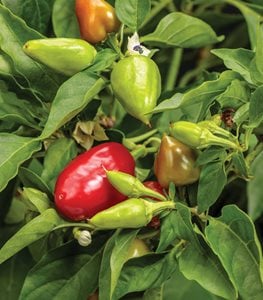
Photo by: Proven Winners.
PEPPERS
This versatile warm weather vegetable comes in hundreds of different varieties, from mild to screeching hot, to suit every taste. Because of the long growing time, plants will need to be started indoors or purchased as nursery starts. Wait to plant outdoors until nighttime temperatures are consistently 60 degrees F or above. Peppers thrive in a sunny site with rich well-draining soil. Add an all-purpose fertilizer formulated for vegetables to the soil at the time of planting and keep plants evenly moist. Plants will need staking or caging to keep from bending over or breaking from the weight of the fruit.
Learn more about how to grow peppers.
Buy Fire Away® Hot and Heavy pepper plants and seeds from Proven Winners.
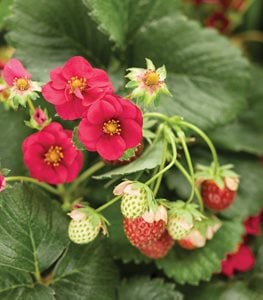
Photo by: Proven Winners.
BERRIES
Though they are not vegetables, berries are a must-have addition to any edible landscape. Choose varieties that produce fruit at different times during the summer for a longer harvest. For those with limited space, select dwarf varieties that can be grown in containers. Blueberries need at least two plants for cross pollination, while other types are self-pollinating. Make sure to research cultural needs for each type. Plant in full sun, keep plants well watered during summer and cover with bird netting when berries start to ripen.
Learn more about growing strawberries.
Buy Berried Treasure® strawberry plants and seeds from Proven Winners.
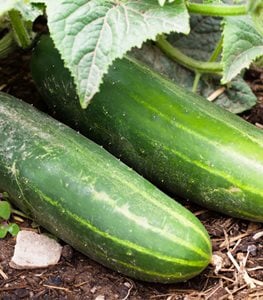
Photo by: Nolte Lourens / Shutterstock.
CUCUMBER
These heat lovers are a favorite crunchy addition to salads, as well as for snacking or pickling. For best results, wait to direct sow seeds until the soil warms up to 60-70 degrees F. Train these vining plants on a fence or trellis, or allow them plenty of room to sprawl. Make sure plants receive plenty of regular water to keep fruit from becoming bitter or misshapen. Harvest frequently to encourage new fruit.
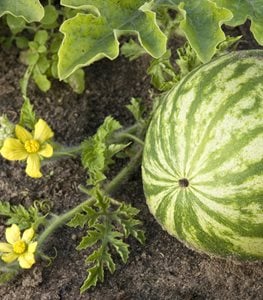
Photo by: Valery Kraynov / Shutterstock.
MELONS
Biting into a sweet, juicy melon slice is one of summertime's greatest pleasures. Melons need lots of heat, water, rich soil, and fertilizer to develop ripe, succulent fruit. Choose a south-facing site that receives reflected heat and allow plenty of room for vines to sprawl. Wait to sow seeds until soil temperature is 65-70 degrees F, or plant from nursery starts. Use heat-enhancing methods such as a cloche or black plastic to warm the soil and speed plant growth.
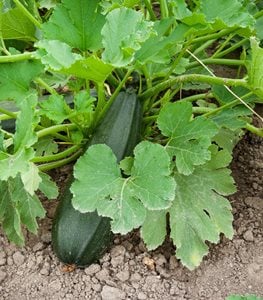
Photo by: Andrei Nekrassov / Shutterstock.
SUMMER SQUASH
Unlike winter squash, these heat-loving vegetables do not store well and are best eaten fresh. Types include green and yellow zucchini, crookneck, straightneck, pattypan, and zephyr. Choose a sunny site with rich, well-draining soil. Plant in rows or hills and direct sow seeds when soil temperature reaches 70 degrees F. Plants need 1 to 2 inches of water per week. Use drip irrigation to reduce the risk of foliar disease. Male flowers are followed by female flowers that bear fruit.
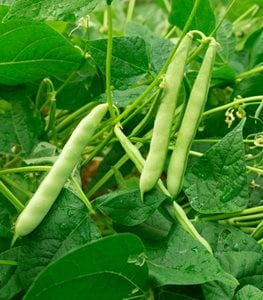
Photo by Kateryna_MA / Shutterstock.
BEANS
A powerhouse of nutrition, beans are one of the best sources of vegetative protein. Beyond the ever-popular green beans, there are other types to grow, including black, pinto, lima, and fava beans. Direct sow seed outdoors when soil temperature reaches 60 degrees F and air temperature is 65 to 85 degrees F. Pole beans can be harvested from mid-summer into fall, while bush types can be sown every couple of weeks throughout summer for a continuous crop. Utilize space-saving trellises and containers to maximize production.
Learn more about growing beans.
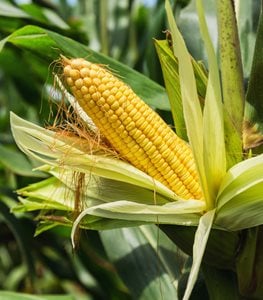
Photo by lovelyday12 / Shutterstock.
CORN
Fresh sweet corn is the quintessential summer crop, a favorite treat at barbecues and picnics. This fast-growing vegetable needs plenty of fertilizer and water to produce tender, plump kernels. Plant in 4 x 4 foot squares or multiple rows to ensure successful cross-pollination. Harvest just before eating, freezing, or preserving for the best flavor. For a unique twist, grill fresh ears and try different toppings such as aioli, pesto, mayonnaise, or fresh herbs.
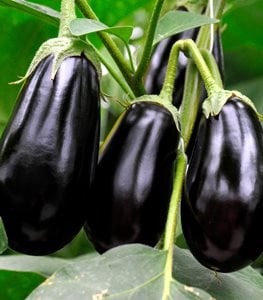
Photo by: Philippe Motigny / Shutterstock.
EGGPLANT
This delicious vegetable is prolific and easy to grow when planted during the heat of summer. In cooler climates, use heat-enhancing methods such as a cloche or black plastic mulch to warm the soil and speed growth. Provide plenty of sun, rich soil, and regular water. Harvest fruits when they are young for the best flavor. For a quick and easy side dish, brush eggplant slices with olive oil and grill on the barbecue. Season with salt and pepper and garnish with fresh herbs, cheese, pesto, or other condiments.
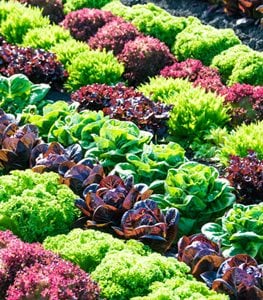
Photo by: David Litman / Shutterstock.
GREENS
Though salad greens are normally a cool weather crop, there are still ways to enjoy fresh greens throughout the summer. Choose varieties such as Malabar spinach and New Zealand spinach that thrive in heat. Mustard, collards, and Swiss chard are both heat and cold tolerant. Even regular lettuce can be grown during the heat of summer when given shade and plenty of water. Re-sow every couple of weeks and harvest when leaves are young. Germination rate decreases when soil temperature exceeds 80-85 degrees F. Heat-resistant lettuce varieties include 'Jericho', 'Red Sails', and 'Buttercrunch'.
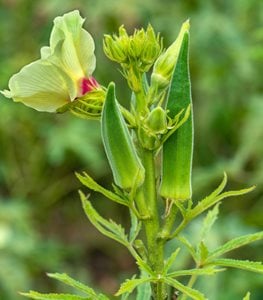
Photo by: Hari Mahidhar / Shutterstock.
OKRA
A staple in Southern cuisines, okra is used to thicken soups, stews, and Creole gumbo. This easy-to-grow vegetable thrives in warmer regions due to its extreme tolerance to heat and drought. Edible seed pods are produced in just 50-60 days from germination. Directly sow seeds outdoors in rich, well-draining soil when soil temperature reaches 65-70 degrees F. Though okra is drought-tolerant, it produces better yields when receiving regular water. Harvest a few days after flowering when pods are still small for best texture and productivity.
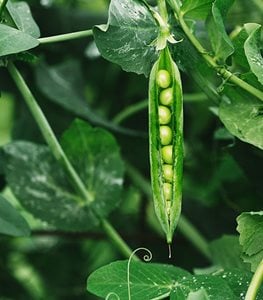
Photo by: Irina Bg / Shutterstock.
PEAS
Though peas are normally a cool weather crop, they can be replanted in mid to late summer for a fall crop. To calculate the best time to plant, determine your average first frost date, subtract the days to maturity listed on the seed packet, and allow an extra week for germination. Seeds can be soaked in water overnight to speed germination. Shade new seedlings from sun during the hottest part of the day and mulch with organic matter to help reduce soil temperature. Keep plants well watered to develop flowers and pods.
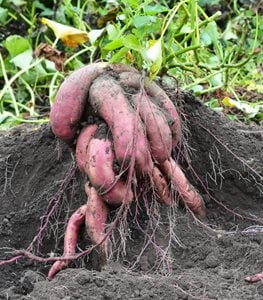
Photo by: Radovan1 / Shutterstock.
SWEET POTATOES
This nutrient-dense vegetable is a rich source of beta-carotene, vitamin A, vitamin C, fiber, and trace minerals. Unlike regular potatoes, this tuberous vegetable is tropical in origin, needing several months of heat to thrive. Once soil temperature reaches at least 60 degrees F, plant tuber slips in a sunny site with rich, well-draining soil. Keep evenly moist with 1 inch of water per week. Cease watering 2 to 3 weeks before harvesting when foliage begins to turn yellow.
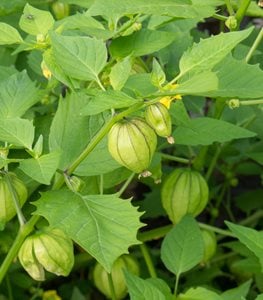
Photo by: Peter Turner Photography / Shutterstock.
TOMATILLOS
Small rounded green fruits of this tomato relative grow inside papery husks. The tart fruits are a staple ingredient in Mexican cuisine, used to make green salsa or enchilada verde sauce. Tomatillos are especially cold-sensitive, preferring soil temperatures of 70-80 degrees F. Start seed indoors 4 weeks before your last frost date or purchase nursery-grown plants. Most varieties take 75-100 days to mature. Make sure to grow two or more plants for successful cross-pollination.
6 SUMMER VEGETABLE GROWING TIPS
- Grow regionally: Pick varieties that will do well in your particular area. If your growing season is shorter, select types that mature faster. For hotter climates, select heat-tolerant varieties.
- Mulch: Spread a 1- to 2-inch layer of compost or other organic matter around plants. This will help conserve water, suppress weeds, and cool soil temperatures.
- Watering: Irrigate plants in the morning to reduce evaporation and avoid foliar diseases. Drip irrigation helps conserve water and reduces disease due to overhead watering. Proper watering is especially crucial when fruits are forming.
- Provide shade: Crops such as greens, peas, broccoli, cauliflower, and beets benefit from partial shade during the hottest part of the day, particularly in warmer climates. Plant in a site that receives protection from hot afternoon sun or use a shade cloth.
- Plant successively: Re-sow crops such as bush beans, beets, and lettuce every couple of weeks throughout the summer for continuous harvest. Start fall crops in mid to late summer.
- Harvest: Pick crops early or late in the day. Produce will stay crisper, fresher and more flavorful than vegetables harvested during the heat of the day.
RELATED:
How to Start a Vegetable Garden
Companion Planting
Garden Edibles: Success Secrets
15 Picks for Your Fall Vegetable Garden
What To Grow In A Garden In The Summer Patio
Source: https://www.gardendesign.com/vegetables/summer.html
Posted by: boydurnow1985.blogspot.com

0 Response to "What To Grow In A Garden In The Summer Patio"
Post a Comment